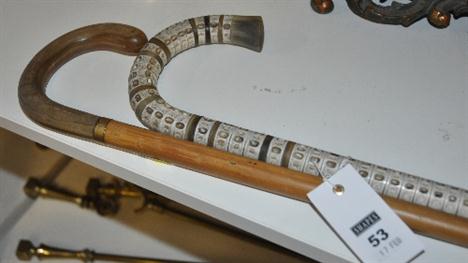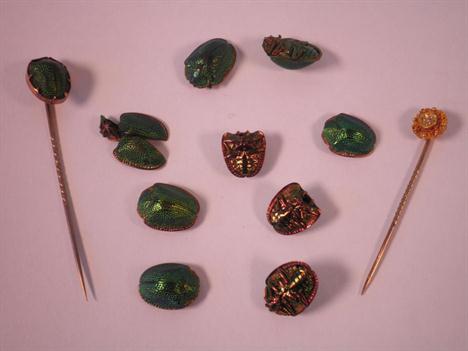We found 133746 price guide item(s) matching your search
Receive email alerts when new lots matching "stick" come up for sale.
Receive email alerts when new lots matching "stick" come up for sale.
There are 133746 lots that match your search criteria. Subscribe now to get instant access to the full price guide service.
Click here to subscribe- List
- Grid
-
133746 item(s)/page
A gold bracelet in an oval and bar link design, on a snap clasp, detailed 333, a stick pin, cased, a bar brooch, two thimbles, a ladies silver waistbelt buckle, with cast and scroll pierced decoration, Birmingham 1899, part of a ladies waistbelt, two two-piece buckles and two further items, with a box.
A gold, peridot and seed pearl set pendant, with foliate pierced decoration, detailed 15, a Victorian oval shell cameo brooch, carved as the figure of a girl with a sheep in a landscape scene, a gilt metal pendant locket, with a gilt metal neckchain, a gold bar brooch, a coral stick pin, five further stick pins and a diamond set motif.
A George IV inlaid mahogany bulb cistern tube mercury stick baroemter J. Furby, Ripon, early 19th century With oval fan cartouche inlaid shaped crest above glazed rectangular printed paper scale annotated for SUMMER and WINTER within fine rococo scroll printed borders, the lower margin with ribbon banner signed FURBY, RIPON with simple wire recording pointer to exterior, above plain trunk applied with central half-round moulding to protect the tube, the base with oval cistern cover inlaid with a conforming fan cartouche, 105cm high. J. Furby of Ripon appears to be unrecorded, however the current lot bears similarities with the work of Charles Howorth of Halifax and George Purcheon of Leeds who both produced instruments using the same basic template for the printed scale, (see Banfield, Edwin BAROMETERS Stick or Cistern Tube pages 112 & 115).
A Fine George III mahogany mercury cistern tube stick barometer James Long, London, circa 1800 With ivory vase finial to the broken triangular pediment with concave bracket supports to sides, above rectangular silvered vernier scale calibrated in inches, with the usual observations and signed Ja`s Long, Royal Exchange, LONDON to upper margin, behind ebony line bordered glazed door above trunk with vernier setting square and inset with a large mercury Fahrenheit scale thermometer behind conforming glazed door, the rounded base with decorative turned ivory disc centred domed cistern cover and level adjustment screw to underside, 98cm high overall. James Long is recorded in Banfield, Edwin BAROMETER MAKERS AND RETAILERS 1660-1900 as working in Royal Exchange, London 1769-1811.
A fine Regency mahogany bowfronted cistern tube mercury stick barometer Dollond, London, early 19th century With swan-neck pediment and cavetto cornice above silvered vernier scale calibrated in barometric inches and with the usual observations beneath signature Dollond, LONDON to upper margin, the bowed trunk with vernier adjustment key to throat and ebony line inlaid edges, the shaped base with ebonised half vase turned cistern cover flanked by canted angles decorated with ebony line infill, the cavetto moulded underside with level adjustment square, 100cm high excluding finial. Peter Dollond is recorded in Banfield, Edwin BAROMETER MAKERS AND RETAILERS 1680-1860 as born 1730 and died 1820. He was the son of John Dollond, a Huguenot silk weaver and started business as an optician in 1750. He was joined by his father in 1752 until his death in 1761, and then by his brother, John, until his death in 1804. The family businesss was continued by Peter Dollond’s nephew, George Huggins, who changed his surname to Dollond. George Dollond became instrument maker to William IV and Queen Victoria, exhibited at the Great Exhibition in 1851 and died 1856.
A patinated brass Kew pattern marine or station stick barometer Adie, London, mid to late 19th century With domed brass cap above glazed cylindrical silvered vernier scale calibrated in inches (26.6 to 32.5) and centimetres (66.5 to 80.5) and signed Adie, London, No. 1359 to lower edge, the cylindrical shaft with vernier adjustment screw and concealed-bulb mercury thermometer with ivory Fahrenheit scale above canister shaped cistern (tube lacking), mounted via gimbals onto original mahogany back panel, the instrument 95cm high, 106cm high overall. Patrick Adie, son of the renowned Scottish Instrument maker Alexander Adie (1775-1858) is recorded in Banfield, Edwin, BAROMETER MAKERS AND RETAILERS 1660-1900 as working from several addresses in London 1846-86. In around 1855 Patrick Adie and John Welsh of the Kew Observatory worked together to develop an improved design of marine barometer. Their design incorporated a sealed iron cistern and the tube featured dampening constriction and Bunten air trap. The thermometer bulb is enclosed within the frame to measure the temperature of the mercury within the barometer tube, the outer brass case offered increased protection compared to earlier wooden cased models.
A late 19th Century European Bone and Silk Fan, of 18 stick construction, with gilt metal pivot and suspension, the outer spines with pierced foliate detail and fitted with a silk body decorated to the centre with musical trophies and flanked by cartouches depicting peasants, within further gilt highlighted floral and foliate swag detail and sewn sequins, to a plain back, length 8 ½”, in a fitted morocco type gilt highlighted case
Victorian silver trinket box of circular form with embossed fluted decoration in a stylised wave pattern, gilded interior and detachable cover (London 1891), an Edwardian silver circular tray with reeded scroll border on four paw feet (Sheffield 1905) George V silver taper stick with bead edge (Chester 1911) and a contemporary circular footed dish (Birmingham 1968), together with sundry other silver items, all at approximately 14ozs, trinket box 8.5cm diameter (qty)
-
133746 item(s)/page
















































